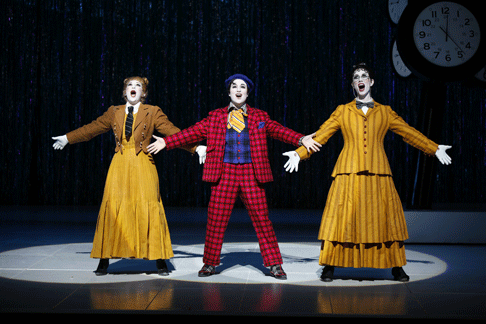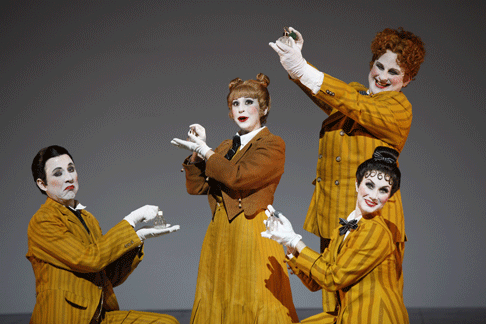This would be most unsuitable — if this
post-Offenbach operetta of 1877 were anything but a perfection of
ridiculousness. The gentlemen in bowler hats, bouncing up and down like
pistons! the ladies whose mourning frocks and veils are instantaneously
transformed into the can-can frippery of rejoicing! the lead singers on
scooters! the backdrop that itself becomes tipsy when the mad King Ouf sings a
tribute to Chartreuse (the lighting changes at that point too)! the fun-house
mirrors that enclose (and might as well describe) the action — which will
strike Americans as “Gilbertian,” though Gilbert got his ideas from
Offenbach, too.
In the City Opera’s quest to re-establish and re-present itself to New
York as the opera company that does what the Met isn’t going to do,
Chabrier (the production has already been seen there in 2002) is an excellent
place to start. The melodies are light in a slyer way than Offenbach’s,
with more opportunity for harmonious display, as in the “kissing”
quartet in Act III. The choruses are not mere background, and in the Lamos
production give the City Opera ladies and gents a chance to strut to a Broadway
standard, all the while singing at a rather higher one. The wit of the piece is
the kind of froth that so often evaporates when the Met attempts operetta, and
it wouldn’t work at NYCO either if it were not so elegantly presented and
if we were not all used to surtitles by now. Ideally, such a work should be
given in the vernacular and in a small house, but that’s true of
Rossini’s comic operas too — and of Shostakovich’s The
Nose, for that matter, concurrently doing sell-out business across the
plaza.
The story of L’Etoile makes one reflect on the deep
philosophical import of The Mikado. The tyrant here, King Ouf I (I
guess that should be le Roi Ouf Ier), always celebrates his birthday with
festivities climaxing in a public execution. Knowing this, his subjects are on
their best behavior at that time of year — but Lazuli, a boy from out of
town, falls into the trap of resenting the world because he is unhappily in
love with a strange girl he met on the road. Before he can be impaled on a
booby-trapped armchair, however, the royal astrologer discovers that he —
Lazuli — is destined to die precisely one day before the king does. (Date
unspecified.) The king thereupon decides to spare the boy — which is good
news for Siroco, the astrologer, whom the king has condemned to die fifteen
minutes after the king does. But Lazuli does not want to live without
his adored Laoula — despite the fond attentions of the ladies of the
court — and attempts to drown himself. And Laoula, it turns out, is not a
traveling cosmetics saleswoman (her disguise) but the princess next door,
betrothed to King Ouf. Ouf, like Gilbert’s Koko, prefers life to
love-death and orders the lovers wed. “And we’ll have two
executions next year,” he consoles his delighted subjects.
 Jennifer Zetlan as Laoula, Julie Boulianne as Lazuli, and Liza Forrester as AloËs
Jennifer Zetlan as Laoula, Julie Boulianne as Lazuli, and Liza Forrester as AloËs
Everyone loves a comic villain, and Jean-Paul FouchÈcourt’s King Ouf
is the joy of this occasion — as he was in his NYCO debut as
Rameau’s frog-nymph PlatÈe. He is the joy of the costume
designer Constance Hoffman as tiny Ouf stomps about “in disguise”
in the largest overcoat in captivity, and the joy of the conductor, the joyous
Emmanuel Plasson, as he warbles his song of Chartreuse ecstasy, his high tenor
mated with FranÁois Loup’s low bass, and he is the joy of everyone
present as he caricatures tiny men with too much power, in his bloodthirst, his
lust, his cowardice, his egotism. I heard FouchÈcourt last month singing
Satie’s Socrate to accompany Mark Morris’s choreography;
he was splendid, but he’s far too much fun on stage to let him languish
in any pit. Morris should have let him dance.
I was less thrilled with Julie Boulianne as the boyish Lazuli, on purely
vocal grounds. Like so many boyish roles in French opera (and theater), the
part is written for a young woman, and when Frederica von Stade sang it, her
famous charm and musicality conquered all. But Boulianne, though she has a
solid technique and many pretty notes (at least high ones — she faded out
on lower lines), suffered intonation problems throughout the first act, often
landing just shy of otherwise good, clear tones. Too, her trilled
“kisses” lacked body, and the joke is not a good one without
genuine trills. Only in the quartet, when obliged to intone the extremely
musical name “La-ou-la,” did her vocal appeal make the proper
effect.
 William Ferguson as HÈrisson de Porc-…pic, Jennifer Zetlan as Laoula, Andrew Drost as Tapioca, and Liza Forrester as AloËs
William Ferguson as HÈrisson de Porc-…pic, Jennifer Zetlan as Laoula, Andrew Drost as Tapioca, and Liza Forrester as AloËs
Tiny Jennifer Zetlan was charming as the princess, but tall Liza Forrester,
as her confidant and abettor in tickling strange sleeping men, had a mezzo that
made me daydream of hearing her in many larger, more rewarding roles. The
supporting parts in this opera are numerous and were all cast with City Opera
folk who sang elegantly and cavorted stylishly. Style, the essence of Chabrier,
was also the essence of the silly evening.
John Yohalem
image=http://www.operatoday.com/L_Etoile0040.gif
image_description=Jean-Paul FouchÈcourt as King Ouf and FranÁois Loup as Siroco [Photo by Carol Rosegg courtesy of New York City Opera]
product=yes
product_title=Emmanuel Chabrier: L’Etoile
product_by=King Ouf I: Jean-Paul FouchÈcourt; Lazuli: Julie Boulianne; Laoula: Jennifer Zetlan; AloËs: Liza Forrester; Siroco: FranÁois Loup. Chorus and orchestra of the New York City Opera, conducted by Emmanuel Plasson. Production by Mark Lamos. New York City Opera, performance of March 20.
product_id=Above: Jean-Paul FouchÈcourt as King Ouf and FranÁois Loup as Siroco
All photos by Carol Rosegg courtesy of New York City Opera